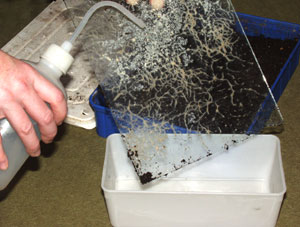
Grindal worms (Enchytraeus buchholzi) are very easy to keep and breed, and make an excellent food for small to medium fish. A typical harvest will contain numerous larger (up to 1cm) and smaller worms (1mm or smaller) suitable for even tiny fry, and what's more, these worms will live happily underwater without dieing and causing pollution. This is an ideal situation to feed tanks of immature killies. Some individuals of certain species (like Nothobranchius palmqvisti Gezani, above) may outgrow, and ultimately predate on their smaller siblings. Grindal worms provide ample food for fry of all sizes, and unlike artemia, don't all bunch together in one area of the tank. Importantly, all fish get a chance to feed.
The worms and media are kept in plastic food storage boxes, loosely lidded, with ventilation holes. Each culture is fed and harvested at the same time approximately every 24 hours. Cultures live indoors on the top (warmest) shelf of the fish room all year round. It is important to allow the worms ample ventilation; cultures with no air can crash very quickly, however they should not be allowed to dry out.
The traditional culture media for grindal worms is much the same as for white worms: a blend of coir (45%), peat/compost (45%), a small amount of sand (10%), maybe a handful of lime to maintain alkalinity. Cultures will turn acidic eventually and should either be replaced with new cultures if production drops, or partially replaced continuously (I take a few handfuls of media to a fish auction every now and again, and then top up the old culture). Activated carbon can be added to the media. The media should always be damp, yet never waterlogged or sodden.
Another method for housing grindal worms, and one that works very well indeed, is to keep the worms in damp sponge. Simply cut a rectangle of open-pored sponge, maybe three to four centimetres thick, and place it in half a centimetre depth of water in the food storage box. This is the perfect media for grindal worms, maintaining the correct humidity, and providing a huge area for the worms to inhabit. The sponge may need to be rinsed out periodically, especially if production drops.



Whichever media the worms are kept in, they are fed the same way: on (under) glass plates. I sprinkle a light layer of fine instant oat cereal on the damp glass, and place face down on the culture. Keeping the food on the glass keeps the culture fresh, minimises mold and mites, and draws the worms to the glass for easy harvesting.
The worms are collected 24 hours later, simply by running clean water over the glass. The glass can then again be reloaded with food.
These really are one of the easiest livefoods available for killifish keepers. Provided cultures are kept warm and well fed they can provide daily worms for months with no real problems. Cultures should be restarted when production drops off. Many people complain about mites within their cultures, and moth balls can be used, however if the food is under a large enough piece of glass this is rarely a problem. In fact mites can act as an additional food source for surface feeding killies.
Grindal worms make a superb food for most small and medium sized killifish. Quicker growing annual fish such as Nothobranchius will take grindal worms fairly quickly after artemia, often within their first week. Make sure you feed very small numbers if you have a substrate in your tank, as worms will bury themselves, eventually dieing under the gravel. As is the case with white worms, apple and rams-horn snails will eat grindal worms given the opportunity.
10 day old Nothobranchius furzeri eating grindal worms This is a still from a short video clip. Click the the image to go to youtube and play the clip. Note there is a high resolution version (just below the image on youtube, look for the 'watch in high quality' link)
$15
$16
$21
$19
$15